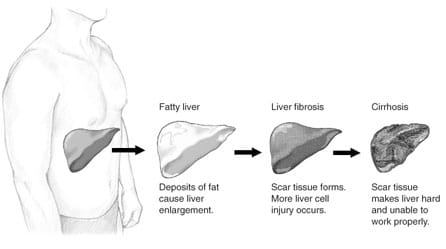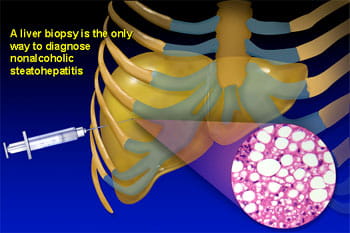What is Metabolic Dysfunction-Associated Steatotic Liver Disease?
Metabolic Dysfunction-Associated Steatotic Liver Disease (MASLD), formerly Non-Alcoholic Fatty Liver Disease (NAFLD) is a condition where too much fat builds up in the liver. The buildup of fat can cause inflammation and liver cell injury in some people, a condition known as Metabolic Dysfunction-Associated Steatohepatitis (MASH), formerly known as Non-Alcoholic Steatohepatitis (NASH). Over time, MASLD can lead to scarring or fibrosis in the liver, especially if MASH develops. This can eventually lead to cirrhosis or liver failure.
MASLD affects people who drink little to no alcohol. It is most often seen in people who have other comorbidities (medical conditions that exist with another diagnosis and affect health) such as overweight, obesity, type 2 diabetes, high cholesterol and high triglycerides.

What Causes Steatotic Liver Disease?
MASLD is caused by many factors, including genetic risk and environmental factors, such as dietary factors and low levels of physical activity. Risk factors that increase the risk of developing MASLD and MASH include:
- Overweight and obesity
- Metabolic syndrome
- Diabetes and insulin resistance
- High levels of triglycerides in the blood (fat in the blood)
- Underactive thyroid
- Underactive pituitary gland
- Race and ethnicity (people with European, Hispanic and Native American ancestry are at greater risk)
- Polycystic ovary syndrome
What are the Signs and Symptoms of MASLD?
Children with MASLD may not have any symptoms. If risk factors are present, your child's doctor may check their liver enzyme levels by taking a sample of blood. They may also order a blood sample if your child has:
- Pain in the right upper part of the belly
- Weakness or fatigue
- Loss of appetite
More advanced stages of MASLD may have different symptoms. These may include:
- Yellowing of skin and the whites of eyes (jaundice)
- Easy bruising or bleeding
- Swollen belly (ascites)
- Constant itchiness (pruritus)
Causes of High Liver Enzymes
High liver enzymes are often seen in MASLD, especially when MASH is present, the more inflammatory form of MASLD. MASLD can be present even if liver enzymes are normal. When liver enzymes are elevated or if there are symptoms of liver disease, it is important to evaluate for other causes, including:
- Viral infections
- Certain medicines that can injure the liver
- Muscle injury
- Gallstones
- Autoimmune or genetic causes of liver disease
Your child's doctor will recommend further testing if your child's liver enzymes are high. This may include:
- More blood tests
- Abdominal ultrasound or Magnetic Resonance Elastography (MREL)
- Liver stiffness test (Fibroscan)
How is MASLD Diagnosed?
MASLD is suspected when there are elevated liver enzymes and/or imaging tests that suggest increased fat in the liver (such as ultrasound, MRI or CT scans). The only way to confirm if your child has MASH is to do a liver biopsy. This is the best way to determine the extent of your child’s liver condition. The decision to perform a liver biopsy depends on many factors, such as concern for other causes of the liver disease or to evaluate for scarring in the liver (fibrosis).
A liver biopsy is a test that places a needle through the skin to get a small piece of tissue from the liver. This procedure is done under anesthesia. It usually requires your child to stay in the hospital for 24 hours after the procedure. Your child’s doctor will look at this tissue to see if there is any scarring.
How is MASLD Treated?
Treatment for MASLD and MASH includes reducing fat in the abdomen and liver through healthy eating and managing blood sugar. Treatment also includes increasing physical activity, especially activities that build up skeletal muscle mass. MASLD can be significantly improved, and even reversed, if it is diagnosed before severe scarring or cirrhosis have developed.
Tips for patients and families:
- Encourage your child to follow a healthy portion-controlled diet, with low amounts of saturated fats and refined sugars.
- Offer child-appropriate portion sizes at meals, with a variety of fruits/vegetables, healthy protein sources (lean meats, beans, tofu) and complex carbohydrates (whole grains rich in fiber and nutrients).
- Avoid sweetened drinks, like soda, juices, lemonade, chocolate milk.
- Limit fast food restaurant meals, since this food is usually high in fat, salt and sugar.
- Meet with the dietitian to learn about healthy diet choices for your child and family.
- Increase physical activity and outdoor play to help your child achieve and keep a healthy weight. Resistance training can be helpful in teenagers to increase strength and muscle mass.
- A child with MASLD or MASH should have Hepatitis B and A vaccinations to avoid potential injury to the liver caused by these viral infections.




